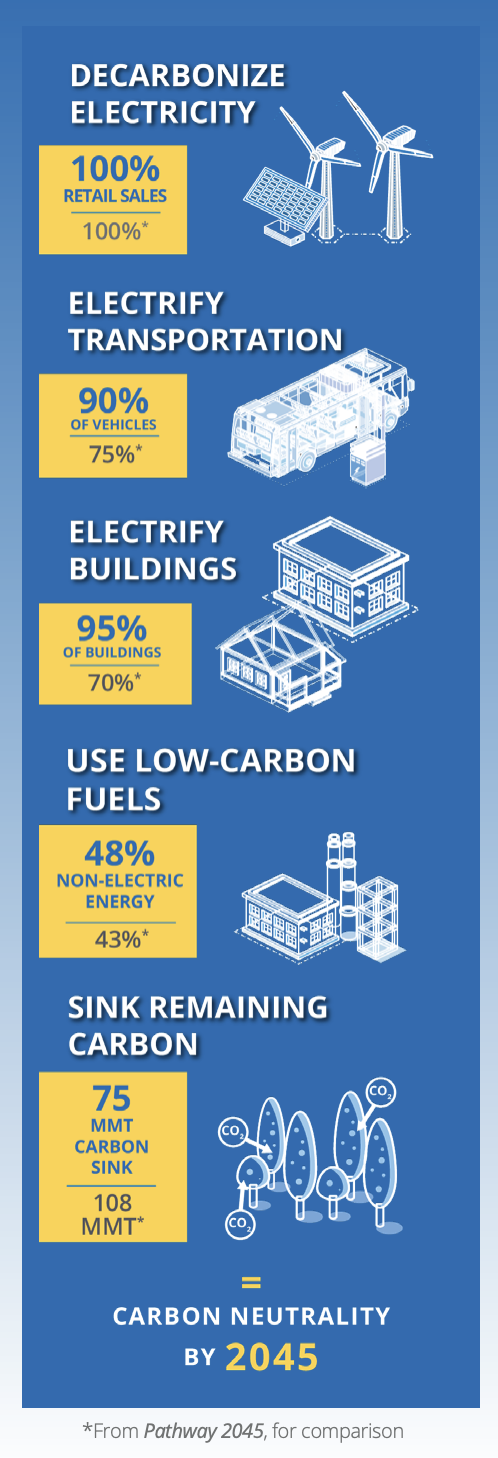Countdown to 2045: Executive Summary
Published 12-05-23
Submitted by Edison International

As people around the world face undeniable climate impacts and sobering risks to their future health and livelihoods, California’s policy to achieve carbon neutrality by 2045 can be a model for other states and nations. However, success requires unprecedented innovation and coordination across planning, policy and technology. Significant electrification — powered by clean generation and enabled by an unparalleled expansion of the electric grid — is necessary to decarbonize the economy feasibly and affordably. Achieving this requires urgent and fundamental changes in how the state’s entire energy infrastructure is planned and built.
Countdown to 2045 updates and expands upon Southern California Edison’s 2019 analysis, Pathway 2045, incorporating policy updates, expected climate change impacts, market and technology developments and an in-depth study of electric sector reliability. Achieving net-zero greenhouse gas (GHG) emissions requires new and emerging technologies to play a large role, but the exact mix and scale remain uncertain. These technologies, including decarbonized fuels, clean and firm generation and carbon removal, must also be advanced while policies and regulations remain open to the full potential of emerging solutions.
California Assembly Bill 1279 is a primary driver of this new analysis by codifying into law the state’s 2045 net-zero goal. It requires direct GHG emissions reduction of 85% by 2045. While achieving net zero is essential, meeting the deeperi emissions reductions mandated by AB 1279 and resulting from other policies drives changes relative to Pathway 2045 that will be more challenging. These include nearly complete building electrification, greater reliance on emerging clean energy resources and electric grid expansion at an even more accelerated pace. These newest requirements limit options such as direct air capture and nature-based carbon removal, and thus may further increase the cost and difficulty of reaching net zero. While AB 1279 calls for an evaluation by 2035 of the feasibility and trade-offs of an 85% reduction, this paper identifies several feasibility challenges that must be taken into consideration quickly, likely well before 2035, as part of the state’s ongoing evaluation of options to meet our decarbonization goals. Without significant policy change and technological development, they could impede our success. Countdown to 2045 outlines near-term actions necessary to address these challenges and realize California’s 2045 climate objectives.
The key findings below describe Countdown to 2045’s solution for California:
- 90% of light- and medium-duty and over 50% of heavy-duty vehicles are electric
- 95% of residential and commercial space and water heating is electric
- Over 3x more utility-scale clean energy resources are online compared to today, primarily through new solar, wind and energy storage
- Up to 15% of utility-scale generation is from new and emerging technologies, such as floating offshore wind and next-generation geothermal
- Distributed energy resources (DERs) play a key role, with 2x and 10x more distributed solar and storage, respectively, compared to today
- New transmission and distribution grid projects added at up to 4x and 10x their historical rates, respectively
- Low-carbon fuels support clean electricity generation and industrial sector GHG emissions reduction
- 75 million metric tons (MMT) of negative emissions technologies sequester remaining emissions
Achieving this transition will take over $370 billion of incremental transmission, distribution and utility-scale clean energy investments. Electric bills will increase due to higher use of electricity for transportation and buildings, but customer savings from reduced fossil fuel expenses will more than offset the increase. The average SCE household will save about 40% on their annual energy expenses by 2045 and benefit from cleaner air.
Countdown to 2045 describes a major leap in the pace of deployment in all aspects of the clean energy transition. This transition depends on specific, near-term actions, including:
System planning must be reimagined by state agencies and utilities for greater speed, efficiency, integration and flexibility
Emerging generation technology needs near-term investment to enable longer-term emission reductions
Process and regulatory reforms are necessary to accelerate transmission infrastructure development
Distribution grid evolution is required for utilities to serve electrification load and fully utilize local energy resources
California has already proven itself a climate leader. Edison International is committed to addressing climate change and offers the ambitious steps described here for California, and to set a strong example for others. While we applaud the state’s recently passed clean energy legislation, further actions are required to ensure we reach our goal. Furthermore, similar transformation is needed worldwide to reduce global GHG emissions at a scale that will meaningfully slow climate change.
i. Prior to AB 1279, Executive Order S-30-05 established a target for 2050 to be at least 80% below 1990 levels.

BACKGROUND
SCE’s 2019 white paper, Pathway 2045, mapped out the energy implications of California reaching its 2045 net-zero goal. Countdown to 2045 reinforces and builds upon the most affordable and feasible path identified in Pathway 2045, refining the necessary steps to achieve the state’s newest, more ambitious decarbonization goals given technology advancements and adoption, deeper understanding of future climate impacts and improved reliability analysis.
Major policy developments since 2019 include:
Gov. Newsom’s sweeping package of climate measures in 2022, including AB 1279 California Air Resources Board’s (CARB) 2022 Scoping Plan Update1, a key milestone that describes a state decarbonization pathway similar to Countdown to 2045
The governor’s order for 100% zero-emission vehicle (ZEV) sales by 20352, paired with CARB’s transformative requirements3 in Advanced Clean Cars II and Advanced Clean Fleets
California Energy Commission’s (CEC) Equitable Building Decarbonization Program authorized in 20224 with $1.1B in funding to reduce GHG emissions from buildings
CEC’s statewide offshore wind goal of 25,000 MW by 20455
California Independent System Operator’s (CAISO) firstever 20-Year Transmission Outlook introduced in 2022, identifying $30B of needed transmission investments
CPUC’s bolstered resource adequacy requirements to account for all hours of peak days and to raise planning reserve margins for system reliability
Markets and technology have seen complementary developments, including:
- Accelerating consumer adoption of electrification (e.g., light-duty ZEVs in CA increased from 6.8% of new car sales in 2019 to 25% by mid-20236; electric appliances outsold gas appliances nationally for both water and space heating for the first time in 20227)
- Growing momentum for emerging clean, firm resources (e.g., dozens of next-generation nuclear and geothermal companies have collectively raised over $1B and received over $4B in awards from the Department of Energy; global project pipelines for electrolyzed hydrogen grew by 266% in the past year8)
- Infusion of government funding: (e.g., the Inflation Reduction Act (IRA) allocates close to $400B of federal funding to clean energy through a mix of tax incentives, grants and loan guarantees that encourage private investment in emerging clean technologies and individual consumers to adopt EVs, heat pumps, rooftop solar and home batteries)
1. 2022 Scoping Plan for Achieving Carbon Neutrality, California Air Resources Board (Dec. 2022). https://ww2.arb.ca.gov/sites/default/files/2023-04/2022-sp.pdf
2. Newsom, Gavin. Executive Order N-70-20 (Sept. 2020). https://www.gov.ca.gov/wp-content/uploads/2020/09/9.23.20-EO-N-79-20-Climate.pdf
3. Advanced Clean Cars II, California Air Resources Board (Nov. 2022). https://ww2.arb.ca.gov/our-work/programs/advanced-clean-cars-program/advanced-clean-cars-ii; Advanced Clean Fleets, California Air Resources Board (April 2023). https://ww2.arb.ca.gov/our-work/programs/advanced-clean-fleets
4. Equitable Building Decarbonization Program, California Energy Commission (2022). https://www.energy.ca.gov/programs-and-topics/programs/equitable-building-decarbonization-program
5. CEC Adopts Historic California Offshore Wind Goals, Enough to Power Upward of 25 Million Homes, California Energy Commission (Aug. 2022). https://www.energy.ca.gov/news/2022-08/cec-adopts-historic-california-offshore-wind-goals-enough-power-upwards-25
6. Zero-Emission Vehicle and Infrastructure Statistics, California Energy Commission. https://www.energy.ca.gov/data-reports/energy-almanac/zero-emission-vehicle-and-infrastructure-statistics
7. Nationwide sales from AHRI Releases December 2022 U.S. Heating and Cooling Equipment Shipment Data, Air-Conditioning, Heating, & Refrigeration Institute (Feb. 2023). https://www.energy.ca.gov/news/2022-08/cec-adopts-historic-california-offshore-wind-goals-enough-power-upwards-25
8. 1H 2023 Hydrogen Market Outlook: US takes the lead, BloombergNEF (March 2023).

Edison International
Edison International
Edison International (NYSE:EIX), through its subsidiaries, is a generator and distributor of electric power and an investor in energy services and technologies, including renewable energy. Headquartered in Rosemead, Calif., Edison International is the parent company of Southern California Edison, one of the nation’s largest electric utilities.
More from Edison International

